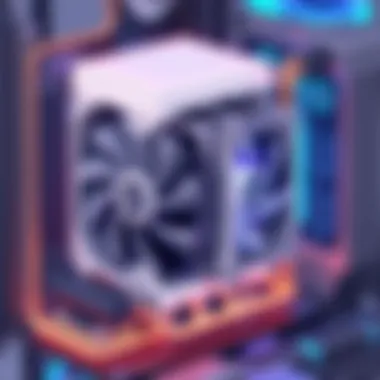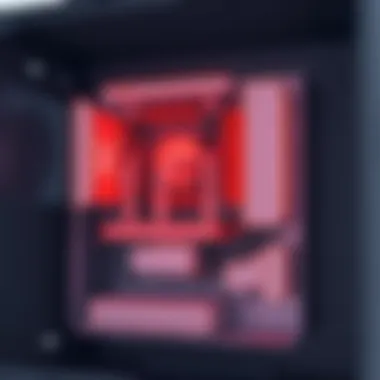Analyzing the Cooling System of Dell XPS 8940


Intro
The Dell XPS 8940 has garnered a solid reputation in the realm of desktop computing, equipped with features that cater to both casual users and hardcore enthusiasts. At the heart of its performance is the cooling system, an often overlooked yet critical component that ensures optimal operation. This article takes a closer look at how this cooling mechanism operates, dissects its design, and explores ways to enhance its efficiency.
As system demands increase, particularly during intense tasks like gaming or video editing, managing heat effectively becomes essential. An efficiently designed cooling system can make a world of difference in maintaining the system's longevity, stability, and overall performance. Within this analysis, we'll uncover the specifications and technologies that define the cooling system of the XPS 8940, how it stands up against common hardware challenges, and what modifications might be undertaken to improve thermal management.
Overview of the XPS
The XPS 8940 is a standout model in the XPS lineup due to its combination of sleek design, robust performance, and notable cooling capabilities. Understanding this system is crucial, especially in the context of thermal management, as efficient cooling directly impacts performance and longevity. The XPS 8940 caters to both casual users and professionals who demand high-quality computing while reining in the heat generated by its internal components.
Prologue to the XPS Line
The XPS line from Dell has always been associated with innovation and high-performance. From its inception, it was geared toward delivering power and efficiency in a compact form. The XPS 8940 continues this tradition, offering a blend of aesthetic appeal and competent hardware. This desktop, with its modern design, addresses the growing demand for machines that not only perform well but also fit seamlessly into a workspace.
Key Specifications
When dissecting the XPS 8940, several key specifications emerge:
- Processor Options: Equipped with options ranging from Intel Core i5 to i7, offering brisk performance for multi-threaded applications.
- Memory Capacity: It supports up to 64GB of DDR4 RAM, allowing for smooth multitasking and high-performance needs.
- Storage Solutions: Users can choose between SSD and HDD options, promoting speedy data access and enough space for storage.
- Graphics: Designed to accommodate discrete NVIDIA GeForce GTX or RTX cards, bringing stunning visuals and rendering capabilities.
These specifications only paint part of the picture; understanding how they interrelate with the cooling system reveals the true potential of the XPS 8940.
Target Audience and Use Cases
The XPS 8940 is tailored for a wide range of users:
- IT Professionals: Those who require stability and power for programming, virtualization, or running demanding software will find a reliable partner in this desktop.
- Gamers: With adequate GPU options, gamers can enjoy an immersive experience without worrying about thermal throttling during intense gameplay.
- Content Creators: Designers and video editors will appreciate the balance of power and cooling efficiency, enabling smoother editing workflows.
- Casual Users: For everyday tasks such as browsing and office applications, the XPS 8940 delivers a premium experience that outstrips typical consumer options.
In summary, the XPS 8940 combines formidable specifications with an efficient cooling system that holds relevance across various use cases, ensuring a consistent performance tailored for diverse needs.
"A tool is only as good as its ability to manage the heat of operation, and the XPS 8940 masters this chore."
Ultimately, this section lays the groundwork for a deeper exploration of how its cooling system contributes to maintaining optimal performance in the forthcoming sections.
Importance of Cooling Systems
Cooling systems play a crucial role in computer performance, especially in systems like the Dell XPS 8940. As modern computers become more powerful, they also generate more heat. Without effective thermal management, overheating can lead to hardware failures, reduced performance, and even system crashes. Thus, understanding the importance of cooling systems is paramount for IT professionals and tech enthusiasts alike.
Thermal Management Principles
At its core, thermal management is about controlling the temperature of a computer's components, ensuring they run within safe limits. Proper cooling strategies include:
- Heat dissipation: This involves removing excess heat generated by the CPU, GPU, and other components. Effective heat dissipations starts with adequate airflow, which can be achieved through well-placed fans and vents.
- Thermal conductivity: Utilizing materials with high thermal conductivity in heat sinks or other components helps transfer heat away from critical areas.
- Heat sink designs: Different designs can optimize heat spreading; for example, fin designs increase surface area for better heat dissipation.
The XPS 8940 leverages these principles with its innovative cooling solutions. Its design not just focuses on eliminating heat, but also on maintaining consistent performance throughout intensive tasks. For instance, the layout of the internal components is tailored to maximize airflow, which, in turn, reduces thermal build-up.
Impact of Temperature on Performance
Temperature significantly influences the overall performance of a computer. As temperatures rise, components may throttle their performance to prevent overheating. This dynamic is vital to understand especially for users who engage in resource-heavy tasks like gaming or complex video editing.


- Elevated temperatures can lead to instability in performance. For a system like the XPS 8940, this means that during peak workloads, if thermal management isn’t up to par, the performance might degrade.
- There are also types of components that react differently as temperatures increase. For instance, while a CPU might resume heavy processing after cooling down, a GPU's performance might become sluggish until the temperature drop is adequate.
Maintaining an optimal temperature not only enhances performance but also prolongs the lifespan of individual components. Neglecting temperature control can result in serious repercussions, from reduced efficiency to complete hardware failure.
Cooling Solutions in the XPS
The cooling solutions in the Dell XPS 8940 desktop are crucial for maintaining system stability and performance. A well-designed cooling system not only prolongs the lifespan of internal components but also enhances the overall user experience. Given that the XPS 8940 caters primarily to power users, gamers, and creatives, it's essential that its cooling architecture can reliably handle intensive tasks without overheating.
This analysis will cover the integral components of the XPS 8940’s cooling system, including airflow design, heat sinks and fans, and the application of thermal paste. Each of these elements works in harmony to ensure that the CPU and GPU run cool and efficiently, allowing users to push their machines to the limit.
Airflow Design
Effective airflow is the backbone of thermal management in the XPS 8940. The casing and internal layout are thoughtfully engineered to promote optimal airflow patterns. The placement of vents, along with the configuration of fans, creates a streamlined process where cool air enters the system and hot air is expelled. This principle is not merely about directing air, but also about avoiding hotspots where heat can accumulate, which can lead to throttling and system instability.
- Inlet and Outlet Positioning: The design includes strategically placed air intakes at the front and top and exhaust outlets at the rear. This layout promotes a front-to-back airflow, keeping the system cool under various loads.
- Fan Speeds and Control: The integrated fans are adjustable, changing speeds based on temperature readings. This dynamic response aids in minimizing noise levels while ensuring optimal cooling performance.
- Vent Size and Filter: The size of vents is also a consideration. Larger vents facilitate greater air intake, while dust filters help in reducing debris that could hinder airflow.
Overall, the airflow design reflects a deep understanding of thermal dynamics, adhering to the principles that dictate heat movement within enclosed spaces. For users who prioritize performance, the benefits are clear: reduced heat translates to improved clock speeds and efficiency.
Heat Sinks and Fans
Heat sinks and fans are the two front-line defenders in the fight against overheating in the XPS 8940. Heat sinks work by absorbing excess thermal energy from the CPU and GPU, while fans then disperse that heat into the surrounding air. Understanding their function and setup can help users make informed decisions regarding upgrades and maintenance.
- Material and Structure: High-quality heat sinks, often made of copper or aluminum, provide maximum thermal conductivity. Their design typically includes fins that increase surface area, allowing efficient heat dissipation.
- Fan Specifications: High-efficiency fans, particularly those with a larger diameter, can move air more effectively without necessitating high RPMs, which often lead to increased noise. This balance is vital for maintaining an optimal working environment.
- Positioning and Integration: Proper positioning of both heat sinks and fans can enhance air circulation. If either is poorly positioned, it can create an inefficient cooling cycle, leading to thermal throttling.
Thermal Paste Application
One often-overlooked aspect of cooling system efficiency is thermal paste application. This material serves as a critical intermediary between heat-producing components and their cooling solutions, ensuring effective heat transfer. Utilizing high-quality thermal paste and applying it correctly can drastically impact the overall thermal performance of the XPS 8940.
- Purpose of Thermal Paste: It fills microscopic air gaps between the CPU or GPU and the heat sink, which would otherwise impede heat transfer.
- Application Techniques: Proper application techniques, such as the pea-sized dot method or spreading paste evenly, can prevent overapplication or insufficient coverage, both of which can lead to poor thermal conductivity.
- Maintenance Recommendations: Thermal paste degrades over time, so it's advisable to replace it every couple of years or after significant temperature spikes. Users can do this during routine maintenance to ensure sustained performance.
By paying attention to the details of thermal paste application, users can optimize the cooling capabilities of their systems, ensuring that the XPS 8940 runs efficiently for longer periods, especially during demanding workloads.
The interplay between airflow design, heat sinks and fans, and thermal paste application makes up the essence of cooling solutions in the XPS 8940. Each of these factors holds substantial influence over the desktop's operational stability, underscoring their importance in the overall analysis of its cooling systems. The understanding of these elements enables users to push their systems without the fear of thermal shutdown.
Performance Metrics
Understanding the performance metrics of the XPS 8940 cooling system is vital for grasping how well the machine manages thermals. These metrics provide tangible benchmarks that reveal the cooling system's effectiveness during various conditions. It's not just a matter of aesthetics or specifications; solid performance measures directly impact system longevity and user experience.
When we talk about performance metrics, we mainly refer to how well temperature is managed under load, how the system behaves when idle, and comparisons with similar models. Evaluating these factors gives insights into reliability and efficiency, which are crucial for enthusiasts and professionals alike.
Performance metrics serve several benefits:
- System Longevity: High temperatures can wear out components faster. Knowing performance metrics allows proactive measures to avoid overheating.
- Optimal Performance: Understanding how cooling impacts the performance of the CPU and GPU helps users optimize settings for various tasks, from gaming to heavy computational work.
- User Satisfaction: Running a cooler system often means quieter operation as fans don't have to work as hard. Lower noise levels enhance user experience.
This section will dive deeper into specific elements of performance metrics, examining the following areas in detail, which we'll tackle next:
Temperature Under Load
Idle Temperature Analysis
Comparative Cooling Performance


These sub-sections will not only talk numbers. Instead, they will contextualize these metrics, providing thorough insights and analysis relevant to the XPS 8940’s cooling system.
Common Cooling Issues
When it comes to the performance of the Dell XPS 8940, understanding common cooling issues is essential. These problems not only hinder optimal performance but can also lead to severe hardware damage over time. Thus, recognizing and tackling these issues directly influences the longevity and efficiency of the system.
Overheating Problems
Overheating stands out as one of the largest foes to computer performance, especially in robust systems like the XPS 8940. The critical point to grasp is that heat is a natural byproduct of any electronic device, but when temperatures rise uncontrollably, components can suffer significant strain. For example, CPUs and GPUs have built-in thermal limits; once these are exceeded, the system can throttle performance to avoid damage. This might reduce the capability for demanding tasks or gaming sessions.
Practically, users experiencing overheating should monitor their system's thermal metrics regularly. One effective way is through software tools that provide real-time temperature readings. When temperatures hover above 80°C, it’s a clear indicator that something isn't right. Solutions can range from checking airflow pathways to considering aftermarket cooling solutions, ensuring that air can travel unobstructed through the casing. Maintaining optimal temperature is not just about comfort; it's about preserving the integrity of the system itself.
Fan Noise and Performance
Fan noise is often an overlooked symptom of potential cooling issues. Many users tend to shrug it off as an ordinary part of a computer's operation, but unusual noises can indicate problems with heat management. For instance, if the fans are persistently loud, it signals that they are working overtime to combat rising temperatures—a sign that the system's cooling capabilities may not be adequate under load.
Users can address fan noise by cleaning the fans and ensuring there are no obstructions. In some cases, replacing or upgrading fans to quieter models can also remedy the situation. Ultimately, a well-functioning cooling system should maintain a balance between temperature regulation and noise—something all users should strive toward.
Dust Accumulation Effects
Dust accumulation is an often underestimated issue that can severely compromise cooling efficiency in the XPS 8940. Over time, dust can settle within the system’s casing, particularly in cooling components like fans and heat sinks. This buildup impedes airflow, trapping heat and creating a hot environment.
It’s vital to recognize the signs—if temperatures are climbing or the system is louder than usual, check for dust buildup. Cleaning the system regularly can be a real game changer. A simple procedure involving compressed air can go a long way in ensuring that dust doesn’t become a detrimental foe in your cooling strategy. Establishing a routine cleaning schedule can keep the XPS 8940 running smoothly, ensuring that performance bottlenecks due to heating are effectively mitigated.
"Dust accumulation is the sneaky thief of cooling efficiency; keep it in check, and your system rewards you with better performance and longevity."
In summary, common cooling issues, such as overheating, fan noise, and dust buildup, can pose serious threats to the performance and lifespan of the XPS 8940. Addressing these problems with proper maintenance and timely interventions ensures that the cooling system holds up under pressure, allowing the desktop to excel under any workload. Understanding these issues expands not only your awareness but also keeps your machine in peak condition.
Upgrading Cooling Solutions
Upgrading the cooling solutions of the Dell XPS 8940 is crucial for maximizing the performance and longevity of the system. With increasingly demanding applications and heavy multitasking, effective cooling is no longer just an enhancement; it's a necessity. This section will navigate through several options that can elevate the cooling efficiency for the XPS 8940, leading to better thermal management and overall system reliability.
Aftermarket Cooling Options
Aftermarket cooling solutions are often sought after by enthusiasts looking for a bit more than what the stock products offer. These upgrades usually come with enhanced performance metrics and innovative features. Considering options from well-known brands like Noctua or Corsair, users can find a plethora of air coolers and liquid cooling solutions that can help maintain optimum temperatures during high workloads.
- Benefits of Aftermarket Coolers:
- Higher cooling capacity
- Lower noise levels compared to OEM fans
- Greater customization options
Many aftermarket options come equipped with larger heat sinks and more powerful fans that can dissipate heat better than the standard ones. However, one must be cautious about compatibility and the physical space available inside the chassis to avoid any fitting issues.
Custom Water Cooling Systems
For those ready to step into the realm of bespoke cooling setups, custom water cooling is a game changer. While this option is slightly more complex, the payoff in temperature management can be significant. Systems can be tailored to individual needs, providing a striking balance of performance and aesthetic appeal.
- Key Considerations:
- Selection of components (radiators, pumps, and water blocks)
- Maintenance requirements and costs
- Potential for leaks and how to mitigate that risk
Setting up a proper custom loop can become an elaborate but rewarding task. It's not just about temperature; it's also about showcasing one’s technical skill. Moreover, the cooling potential can drastically outperform air systems, especially under extreme workloads or overclocking scenarios. Essentially, custom water cooling can turn your XPS 8940 into a powerhouse that runs cold and looks sharp.


Effective Fan Configuration
The right fan configuration can play a crucial role in overall system cooling. A well-thought-out fan layout ensures that airflow is maximized while minimizing noise levels. Users should keep the common intake and exhaust principle in mind: cool air should flow in and warm air should blow out.
- Tips for Effective Fan Setup:
- Ensure a balanced air pressure (neutral or slightly negative pressure)
- Use PWM fans for better speed control
- Position fans strategically to optimize airflow paths
Installing larger fans can also be beneficial, as they can move more air at lower RPMs, reducing noise. It’s essential to evaluate the position of each fan in relation to components like the GPU and CPU, ensuring the hottest parts receive sufficient airflow. Ultimately, a good fan configuration can prevent heat buildup, making it integral for keeping the XPS 8940 in peak condition.
"Cooling solutions are not merely an add-on to the performance equation; they are essential components that dictate how powerfully the system can run, especially in demanding scenarios."
By considering aftermarket options, exploring custom water cooling systems, and fine-tuning the fan configuration, users can significantly uplift the XPS 8940’s cooling capabilities, making it a superior machine in both function and reliability.
Maintenance Practices
Maintaining a computer’s cooling system is vital for ensuring optimal performance and longevity, particularly in the Dell XPS 8940. Neglecting the cooling system can lead to overheating, which not only hampers performance but can also cause long-term damage to critical components. In this section, we will explore essential maintenance practices that can keep the XPS 8940's cooling system working effectively.
Regular Cleaning Procedures
One of the most straightforward ways to maintain cooling efficiency is through routine cleaning. Dust and debris can clog vents and block airflow, leading to rising temperatures. Here’s how to effectively clean your XPS 8940:
- Power Down and Unplug: Always turn off your device and unplug it before starting the cleaning process to avoid accidents.
- Remove Side Panels: Using a screwdriver, take off the side panels of the tower. This will give you direct access to the internal components.
- Use Compressed Air: A canister of compressed air is your best friend here. Carefully blow out dust from fans, heat sinks, and the power supply. Make sure to hold the fans in place while doing this to prevent damage.
- Wipe Surfaces: For any remaining dirt, use a microfiber cloth slightly dampened with water or isopropyl alcohol. Avoid using harsh chemicals that could corrode internal parts.
Tip: Aim to clean your system every three to six months to prevent dust buildup. In particularly dusty environments, you may need to clean it more frequently.
Monitoring Performance Metrics
Monitoring the performance of your cooling system helps detect problems before they develop into serious issues. By keeping tabs on metrics, you can ensure that everything is running at peak efficiency:
- Utilize Software Tools: Programs like HWMonitor or Core Temp can provide real-time statistics on temperature, fan speed, and other metrics. These tools are usually easy to set up and can alert you if temperatures exceed safe levels.
- Check BIOS Settings: The XPS 8940 has built-in BIOS features to monitor temperature. It’s good practice to check these settings on occasion for additional insights.
- Keep a Log: Sometimes, patterns tell the biggest story. Keeping a performance log can help you see if temperature spikes correlate with certain applications or workloads.
Replacing Thermal Paste
Thermal paste is the unsung hero in cooling efficiency. It fills the microscopic gaps between your CPU and cooler, improving heat transfer. Over time, thermal paste can dry out and become less effective.
Here is how the replacement process unfolds:
- Gather Materials: You’ll need high-quality thermal paste, isopropyl alcohol, lint-free cloths, and a plastic scraper or an old credit card for application.
- Clean Old Thermal Paste: Remove the CPU cooler, and then use alcohol to clean the old paste from both the CPU and the heatsink. Make sure both surfaces are completely clean before proceeding.
- Apply New Thermal Paste: A pea-sized amount in the center of the CPU is usually sufficient. When the cooler is reattached, it will spread the paste evenly across the surface.
- Reinstall Cooler: Attach the cooler carefully, making sure to secure it properly to avoid any pressure points.
Reminder: Replacing the thermal paste every couple of years is advisable, especially if you notice increased operating temperatures.
In summary, regular maintenance practices such as cleaning, monitoring performance metrics, and replacing thermal paste are essential for ensuring that the cooling system of the Dell XPS 8940 operates optimally. Proper maintenance can significantly extend the life and efficiency of your desktop, helping you avoid unnecessary headaches down the line.
Finale
The cooling system of the Dell XPS 8940 is not just a collection of fans and thermal paste; it’s a carefully engineered mechanism that plays a crucial role in maintaining the overall performance and longevity of the system. Understanding this system is vital for IT professionals and tech enthusiasts alike, as it directly impacts the user experience from both performance and reliability standpoints.
Recap of Key Takeaways
- Efficient Thermal Management: A robust cooling system helps in managing heat dissipation, ensuring that components function effectively without throttling or overheating.
- Regular Maintenance is Essential: Periodic cleaning and thermal paste replacement can prolong the life of the cooling system, making a noticeable difference in performance.
- Awareness of Common Issues: Addressing overheating, fan noise, and dust accumulation proactively is key to sustaining high performance levels in computing tasks.
The Future of Cooling Technology
As technology continues to evolve, so do the methods employed in cooling systems. Looking ahead, we anticipate several trends that could revolutionize the landscape of cooling solutions:
- Liquid Cooling Adaptation: More consumers are turning to liquid cooling setups. These systems can provide superior thermal management, albeit at a higher cost and complexity compared to traditional air cooling.
- Smart Thermal Management Systems: Devices with integrated software to monitor and adjust cooling based on real-time data. This could mean quieter operations and optimized cooling when it’s needed more.
- Advanced Materials: The use of silicon carbide or graphene may offer enhanced thermal conductivity, potentially leading to more compact and effective cooling solutions.





